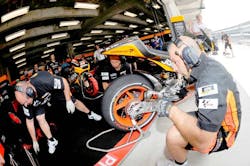Indianapolis MotoGP debrief with Masao Azuma
Repsol Honda’s Marc Marquez capped off an emphatic display of speed at Indianapolis Motor Speedway by claiming his third consecutive MotoGP victory last Sunday ahead of teammate Dani Pedrosa and Yamaha Factory Racing’s Jorge Lorenzo.
Conditions at Indianapolis on Sunday were hot with a peak track temperature of 53°C recorded during the race and as fine weather persisted for the whole race weekend, the riders had ample opportunity to evaluate tyre choices before the race. All slick compounds in Bridgestone’s allocation for the Indianapolis Grand Prix being tested.
Q&A with Masao Azuma – Chief Engineer, Bridgestone Motorsport Tyre Development Department
There was a lot of variation in tyre choice over the race weekend but for the race, no works riders selected the harder option rear slick.
“Indianapolis continued the trend we have seen throughout this season; riders are prepared to choose the softer rear slick option and devise a strategy to make it last the race distance rather than opting for the more durable, hard rear slick. It seems riders want the option that will give them maximum performance at the start of the race, rather than have a tyre option that will offer more consistent grip levels over the race distance. However, reviewing some of the rider comments after the race, I believe that some riders would have had good results had they chosen the harder rear slick available to them, as some did experience a marked drop in tyre performance in the final laps of the race on the softer rear slick. The Indianapolis circuit is very abrasive and the extra durability of the harder option may have offered more consistent performance over the race distance. The challenge for us at the moment is developing new tyres and looking at compound selection so that riders feel there is more of a benefit to selecting harder rear slick options for the race, and work in this regard is ongoing.”
So as all works riders selected the softer rear slick option for the race, how did this perform in what were quite hot track temperatures on Sunday?
“Actually the performance of the softer rear slick for the works riders, the medium compound tyre, was very good. Not only did Marc set a new race lap record, he did so on the eighteenth lap so this showed that the softer rear option exhibited good durability as well as performance so this was a positive for us. This year’s race was a lap shorter than last year, but in our estimation over the same race distance, the overall race time this year would have been about seven seconds quicker than last year – another positive sign. Despite the good performance of the medium compound slick tyre, the data we acquired during Friday and Saturday practice show us that the hard compound rear tyre was also a viable race option for Sunday, but as no rider decided to use it we were unable to make a direct comparison.”
Again this year there was a lot of talk about the track surface at Indianapolis. In regards to the tyres, what makes the tarmac of the Indianapolis circuit challenging?
“Indianapolis has three different types of tarmac; one type used on the oval course, one type on the section starting at turn one that was originally constructed for Formula 1, and the other type is on the infield. The infield tarmac is the most challenging in terms of tyres as not only is it one of the more slippery surfaces seen on the calendar, it is also quite abrasive. Usually if a tarmac is quite abrasive, you supply harder rubber compounds as hard rubber resists wear better. However at Indy we need to also ensure the rubber compounds offer enough grip to counteract the low grip level of the tarmac. It is managing this balance of resistance to wear versus grip at Indianapolis that makes it challenging for tyres. In addition to the tarmac, the layout of the circuit also adds to the challenge with the sequence of left-handed corners from turns twelve to fourteen generating very high temperatures in the left shoulder of the rear tyres. Because of this we employ our heat-resistant construction in the slicks we provide at Indianapolis. As you can see, the Indy circuit presents many challenges for our tyres but given the new qualifying and race lap records set last weekend and the overall tyre performance exhibited, I believe our tyre allocation for Indianapolis was well planned.
